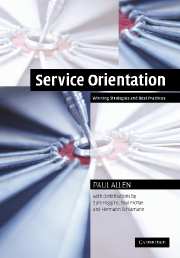Book contents
- Frontmatter
- Contents
- Foreword
- Preface
- Acknowledgments
- List of acronyms and abbreviations
- PART 1 OVERVIEW
- PART 2 BUSINESS ARCHITECTURE
- PART 3 SERVICE-ORIENTED ARCHITECTURE
- PART 4 SERVICE-ORIENTED MANAGEMENT
- 11 The “big picture”
- 12 Service-level agreements
- 13 Cultural factors
- PART 5 CASE STUDIES
- References
- Useful sources of information
- Index
13 - Cultural factors
from PART 4 - SERVICE-ORIENTED MANAGEMENT
Published online by Cambridge University Press: 31 July 2009
- Frontmatter
- Contents
- Foreword
- Preface
- Acknowledgments
- List of acronyms and abbreviations
- PART 1 OVERVIEW
- PART 2 BUSINESS ARCHITECTURE
- PART 3 SERVICE-ORIENTED ARCHITECTURE
- PART 4 SERVICE-ORIENTED MANAGEMENT
- 11 The “big picture”
- 12 Service-level agreements
- 13 Cultural factors
- PART 5 CASE STUDIES
- References
- Useful sources of information
- Index
Summary
Specification before process
There are a host of cultural factors affecting the uptake of service orientation. Many detailed processes are possible. In this book, we have emphasized a lightweight approach to process, introducing process patterns to assist where useful. Our main emphasis, however, has been firmly on deliverables. The view is that if you get the deliverables right then processes will usually follow.
At the same time, cultural change is a lot more than instituting the right processes. Above all, it is about getting the best out of the organization's people and about the market in which the organization chooses to operate. In this chapter, therefore, we resist the temptation to add to the groundswell of procedural guidance – the fact is that organizations evolve and adapt their processes to fit their people and their market. Our focus is on offering guidance on the roles that are required for individuals to play in relation to service orientation, and on sketching some scenarios that depict different market contexts that organizations may find themselves in. Armed with clear guidance on specification, along with role definitions and market guidance, the organization can adapt their processes to maximum advantage.
Supply, manage, and consume
What I first referred to as a “two-tier” process in relation to CBD (Allen and Frost, pp. 12–14, 1998) continues to be relevant to service orientation. This is a model that I further enhanced in relation to e-business in the form of a “track-based pattern” (Allen 2000, pp. 50–2).
- Type
- Chapter
- Information
- Service OrientationWinning Strategies and Best Practices, pp. 245 - 266Publisher: Cambridge University PressPrint publication year: 2006

